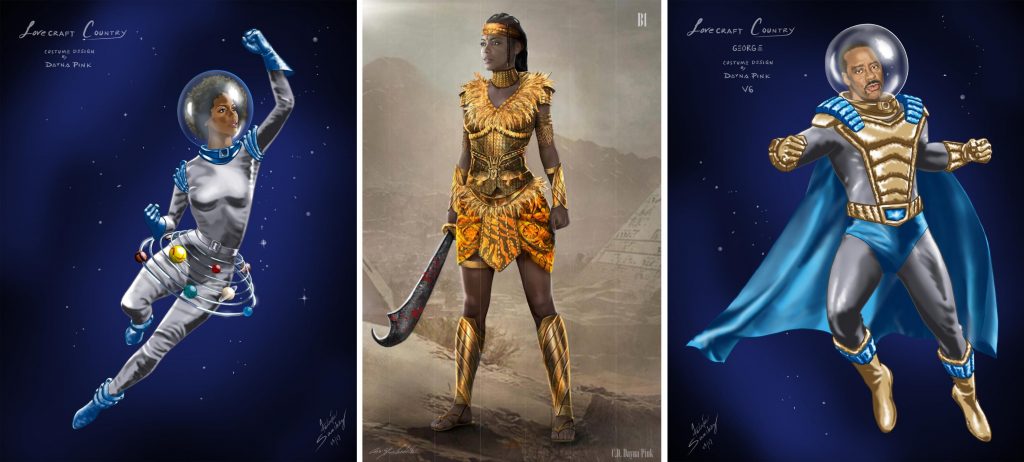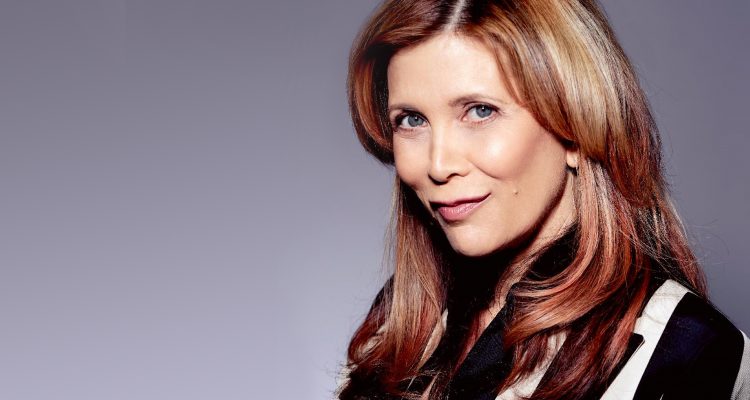With each new project, a costume designer hopes that the material will provide a versatile landscape to showcase a variety of looks for the characters as they evolve through the series.
Emmy nominated costume designer Dayna Pink was given a vast landscape of creative opportunities and challenges. From crafting iconic warrior costumes to designing 1920s Parisian Dancers and retro futuristic space suits, Pink nailed each look with sharp detail.
“As costume designers we are storytellers through our choices,” Pink shares. “We help tell the audience how a character is feeling, what they’re thinking, and where they’re going.”
The HBO limited series, based on the novel by Matt Ruff, sees Letitia ‘Leti’ Lewis (Jurnee Smollett), a young African-American woman travel with her companions Atticus ‘Tic’ Freeman (Jonathan Majors) and his uncle George (Courtney B. Vance) in search of Tic’s father Montrose Freeman (Michael K. Williams). The setting appears to be the 1950s Jim Crow era, however, the series quickly expands to eras and locations that Pink accentuates with her brilliant costume work.
Emmy nominated for the episode “I Am,” Awards Focus spoke to Dayna Pink about her path to getting her first series, the working relationship with creator/showrunner Misha Green, and the impossibly intricate costumes that were finished minutes before cameras rolled.
Awards Focus: In an interview you did earlier this year, you mentioned that ‘Lovecraft Country’ is the first television series that you’ve designed for. How did you find the project?
Pink: I got sent the script by director Yann Demange, the director of the pilot, and then I met with Misha Green (creator/showrunner/writer) and Yann. I wasn’t familiar with the book, but very intrigued by the script.
There were all kinds of modern music cues and things that were not of the period so it was really interesting to me to think about what it would be like to make a show that was period, but have elements in it that were modern.
AF: Speaking of it being a period piece, did you find it difficult to design costumes with the constraints of historical accuracy?
Pink: That was the really magical part of the show for me, in that, we got to work within the period of time and then we got to step outside that period because there was the fantasy element. It was really fun for us to be able to root it in the period and then jump and play in whatever we felt was right for the characters and the scenes.
AF: How many hours total were put into the creation of each costume?
Pink: A lot (laughs). Some of the things we started working on months ahead of time, like the space suits. Television is interesting because you’re not prepping everything at one time, you’re prepping episode by episode.
We still knew what was coming up so we thought about things months in advance, but I can’t give you a time frame because everything was different. Some things were fast and we knew what we wanted, and some things were constructed and then deconstructed and then reconstructed… it’s an evolving process.

AF: About how many people worked on each costume?
Pink: We had so many wonderful people in our crew, especially for this episode (“I Am”). We had crafts people who were helping to make the dancer costumes, and at the same time we were working on all of the stuff for a regular episode. We had a workroom of people building those costumes, maybe thirty people.
AF: Is there a separate team of people in charge of perfecting and maintaining the costumes after they’ve been created?
Pink: Well there’s a set crew that watches the people once we’re on set and then there’s the people at our office and our shop that make things So yes, those are two different parts of our crew.
AF: Did you know right away that this episode was the one that you’d want to be submitted for the Emmys?
Pink: I fell in love with every episode for different reasons, each had immense heart and creativity, but this is the one that showed the most breadth.
It has all different elements from different time periods and fantasy things that didn’t exist. You can’t find a better representation of the versatility of the show than with “I Am.”
AF: Is there a favorite outfit that you have from this episode?
Pink: I don’t know, we literally gave birth to every single piece in that episode so I don’t think I can highlight a favorite.
AF: How did your collaboration with the writers and directors differ from previous projects?
Pink: Misha Green, as a collaborator, was really inspiring to me. She allowed me to create and come up with ideas beyond what was on the page. Her instincts were always right when she pointed us in a certain direction.
The collaboration with her was what makes Lovecraft Country so memorable to me. Her concepts, writing, and vision were the inspiration for everything we did as artists. It was so challenging, but in the best possible way.
AF: Is there a story or anecdote that you have about making and filming the episode “I Am”?
Pink: The craziest thing I remember was making the dancer’s outfits. We did not finish those until hours before they were shot. The seamstresses, and really the whole workroom was working until two or three in the morning putting together those little feather outfits.
We all had hot glue guns and we were gluing sequins and feathers and everyone had a needle and thread. When we finally stood there and watched those dancers come down the stairs, we were just in awe because it was such a feat to get that all put together.
You can’t see any of the worry or the stress of it all, but that really just happened in real time and it was quite a moment to see it all come together.
AF: The episode is about Hippolyta’s own self discovery, I’m curious what creative decisions did you make to accentuate her character?
Pink: It all came from the story. What was interesting was being able to jump out of the 50s and into these other time periods where we were no longer bound by the silhouette of the 50s.
Everything looks and feels so different because it’s a completely different place and a different period, which added to the creativity. As far as telling Hippolyta’s story, it really showed her in another space and time which was part of her growth and evolution so it was really interesting to help create it and have it look completely different from all of the other ways that we’ve seen her up until then.
AF: Having worked in multiple time periods within this series, do have one period that was the most enjoyable or challenging?
Pink: That’s the gift of my job, you fall in love with every period you’re doing! I fell in love with the 50s doing this show. It was really a beautiful period and the fabrics they used were amazing.
Now, I’m doing a show that’s in the 70s and I’m in absolute love with the 70s! I think any time you dive into a period you find out things that are so incredible you can’t help but fall in love. So, I couldn’t pick just one.
AF: How do you utilize your costumes to enhance the characters’ journey?
Pink: As costume designers we are storytellers through our choices… we help tell the audience how a character is feeling, what they’re thinking, and where they’re going.
You watch the characters evolve and you’re evolving with them. You don’t have to make long term decisions for characters at the beginning, you can fall in love and take the journey with them.
AF: What’s next for you as a designer?
Pink: I’ve done a couple shows since Lovecraft Country as well as a film with Channing Tatum, which he’s starring in and co-directing.
Every job that I’ve gotten has brought me incredible excitement and joy, and no experience is the same. Collaborating with my director, the cast, producers, the other department heads… it’s incredibly exciting and fulfilling, and something I hope to do for a very long time.


